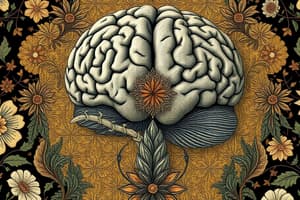Podcast
Questions and Answers
What is the primary objective of conducting an external audit?
What is the primary objective of conducting an external audit?
- To monitor competitor pricing strategies
- To assess employee satisfaction levels
- To identify key opportunities and threats (correct)
- To evaluate internal company performance
Which of the following best describes the external assessment in strategic management?
Which of the following best describes the external assessment in strategic management?
- A comparison of company performance against industry benchmarks
- A process to identify and evaluate external trends and events (correct)
- A review of financial statements for profitability
- An analysis of internal capabilities and resources
Porter’s Five-Forces Model is primarily used for what purpose in strategic management?
Porter’s Five-Forces Model is primarily used for what purpose in strategic management?
- Evaluating a company’s internal processes
- Forecasting future sales revenue
- Understanding the competitive dynamics of an industry (correct)
- Assessing employee skills within an organization
What is one of the key advantages of conducting an external assessment?
What is one of the key advantages of conducting an external assessment?
Forecasting tools and techniques in strategic management are primarily used for what purpose?
Forecasting tools and techniques in strategic management are primarily used for what purpose?
Which of the following is NOT a benefit of using an External Factor Evaluation (EFE) Matrix?
Which of the following is NOT a benefit of using an External Factor Evaluation (EFE) Matrix?
What is an important outcome of identifying external forces impacting organizations?
What is an important outcome of identifying external forces impacting organizations?
Which of the following statements about external audits is false?
Which of the following statements about external audits is false?
Which technologies are primarily driving innovation in various industries today?
Which technologies are primarily driving innovation in various industries today?
What roles do the Chief Information Officer (CIO) and Chief Technology Officer (CTO) typically play in a firm?
What roles do the Chief Information Officer (CIO) and Chief Technology Officer (CTO) typically play in a firm?
Which method is not considered a legal way to obtain competitive intelligence?
Which method is not considered a legal way to obtain competitive intelligence?
What is a vital component of conducting an external audit regarding competitors?
What is a vital component of conducting an external audit regarding competitors?
Which of the following is a benefit of hiring top executives from rival firms?
Which of the following is a benefit of hiring top executives from rival firms?
Which of the following methods involves the least direct interaction with the competitor?
Which of the following methods involves the least direct interaction with the competitor?
What is one key question to consider regarding competitors’ products and services?
What is one key question to consider regarding competitors’ products and services?
Which of the following is NOT a technological force mentioned as threatening competitors?
Which of the following is NOT a technological force mentioned as threatening competitors?
When are barriers to leaving the market considered high?
When are barriers to leaving the market considered high?
Which condition does NOT typically contribute to high rivalry among competing firms?
Which condition does NOT typically contribute to high rivalry among competing firms?
What factor can help overcome barriers to entry in an industry?
What factor can help overcome barriers to entry in an industry?
What element can increase pressure from substitute products?
What element can increase pressure from substitute products?
Which factor is least likely to be a barrier to entry in a market?
Which factor is least likely to be a barrier to entry in a market?
Which scenario would likely result in lower rivalry among competing firms?
Which scenario would likely result in lower rivalry among competing firms?
What contributes to a firm facing low barriers to entry?
What contributes to a firm facing low barriers to entry?
What is a common outcome when consumer switching costs decrease?
What is a common outcome when consumer switching costs decrease?
What condition primarily affects consumer bargaining power when buyers are particularly important?
What condition primarily affects consumer bargaining power when buyers are particularly important?
Which of the following factors typically increases the bargaining power of suppliers?
Which of the following factors typically increases the bargaining power of suppliers?
Which source of external information is categorized as a published source?
Which source of external information is categorized as a published source?
How does product standardization affect consumer power?
How does product standardization affect consumer power?
Which of the following indicates a condition where buyers can switch products easily?
Which of the following indicates a condition where buyers can switch products easily?
What role does consumer information play in bargaining power?
What role does consumer information play in bargaining power?
Which data source would be best for obtaining company-specific financial reports?
Which data source would be best for obtaining company-specific financial reports?
What effect does backward integration have on supplier relationships?
What effect does backward integration have on supplier relationships?
What is the primary purpose of forecasting in management?
What is the primary purpose of forecasting in management?
Which of the following elements is NOT included in the EFE Matrix?
Which of the following elements is NOT included in the EFE Matrix?
What is the scale used to rate the effectiveness of current strategies in the EFE Matrix?
What is the scale used to rate the effectiveness of current strategies in the EFE Matrix?
How are key external factors weighted in the EFE Matrix?
How are key external factors weighted in the EFE Matrix?
What does the formula 'weight x rating' in the EFE Matrix represent?
What does the formula 'weight x rating' in the EFE Matrix represent?
What is the maximum total score possible after summing the weighted scores in the EFE Matrix?
What is the maximum total score possible after summing the weighted scores in the EFE Matrix?
In the context of external factors, what kind of impact do major external factors have according to EFE Matrix?
In the context of external factors, what kind of impact do major external factors have according to EFE Matrix?
What is a likely outcome of making incorrect assumptions in the context of forecasting?
What is a likely outcome of making incorrect assumptions in the context of forecasting?
What is the weighted score for the trend toward healthy eating eroding concession sales?
What is the weighted score for the trend toward healthy eating eroding concession sales?
Which factor has the highest weight in the EFE matrix?
Which factor has the highest weight in the EFE matrix?
How much has the unemployment rate in the county declined to?
How much has the unemployment rate in the county declined to?
What percentage growth in population is noted for Rowan County annually?
What percentage growth in population is noted for Rowan County annually?
Which external factor has a rating of 1 in the EFE matrix?
Which external factor has a rating of 1 in the EFE matrix?
What is the projected growth in demand for going to cinemas?
What is the projected growth in demand for going to cinemas?
What is the combined weighted score for the factors related to declining unemployment and increasing population?
What is the combined weighted score for the factors related to declining unemployment and increasing population?
What is the percentage increase in county and city property taxes?
What is the percentage increase in county and city property taxes?
Flashcards
External Assessment
External Assessment
Analyzing external factors (outside a firm's control) to identify opportunities and threats.
External Audit
External Audit
Process of evaluating external trends and events affecting an organization and identifying opportunities and threats.
Strategic Management Model
Strategic Management Model
Framework for analyzing external and internal factors to develop strategies for a firm
External Forces
External Forces
Signup and view all the flashcards
Porter's Five Forces
Porter's Five Forces
Signup and view all the flashcards
Opportunities
Opportunities
Signup and view all the flashcards
Threats
Threats
Signup and view all the flashcards
Actionable Responses
Actionable Responses
Signup and view all the flashcards
Technological Forces
Technological Forces
Signup and view all the flashcards
Competitive Forces
Competitive Forces
Signup and view all the flashcards
Competitive Intelligence
Competitive Intelligence
Signup and view all the flashcards
Chief Information Officer (CIO)
Chief Information Officer (CIO)
Signup and view all the flashcards
Chief Technology Officer (CTO)
Chief Technology Officer (CTO)
Signup and view all the flashcards
Reverse Engineering
Reverse Engineering
Signup and view all the flashcards
Form 10-K
Form 10-K
Signup and view all the flashcards
Competitive Analysis
Competitive Analysis
Signup and view all the flashcards
High Rivalry
High Rivalry
Signup and view all the flashcards
Easy Brand Switching
Easy Brand Switching
Signup and view all the flashcards
Low Entry Barriers
Low Entry Barriers
Signup and view all the flashcards
High Fixed Costs
High Fixed Costs
Signup and view all the flashcards
Perishable Products
Perishable Products
Signup and view all the flashcards
Substitute Products
Substitute Products
Signup and view all the flashcards
Barriers to Entry
Barriers to Entry
Signup and view all the flashcards
Price Cuts
Price Cuts
Signup and view all the flashcards
Supplier Bargaining Power
Supplier Bargaining Power
Signup and view all the flashcards
Consumer Bargaining Power
Consumer Bargaining Power
Signup and view all the flashcards
Switching costs
Switching costs
Signup and view all the flashcards
Concentrated Buyers
Concentrated Buyers
Signup and view all the flashcards
Standard Products
Standard Products
Signup and view all the flashcards
Backward Integration
Backward Integration
Signup and view all the flashcards
External Information Sources
External Information Sources
Signup and view all the flashcards
Published Sources
Published Sources
Signup and view all the flashcards
Forecasting assumption
Forecasting assumption
Signup and view all the flashcards
External Factors
External Factors
Signup and view all the flashcards
EFE Matrix
EFE Matrix
Signup and view all the flashcards
Weighted Score
Weighted Score
Signup and view all the flashcards
Key External Factors
Key External Factors
Signup and view all the flashcards
Weighting (EFE Matrix)
Weighting (EFE Matrix)
Signup and view all the flashcards
Rating (EFE Matrix)
Rating (EFE Matrix)
Signup and view all the flashcards
EFE Matrix Steps
EFE Matrix Steps
Signup and view all the flashcards
TDB University Expansion
TDB University Expansion
Signup and view all the flashcards
Cinema Competitor Closure
Cinema Competitor Closure
Signup and view all the flashcards
Cinema Demand Growth
Cinema Demand Growth
Signup and view all the flashcards
Rising Disposable Income
Rising Disposable Income
Signup and view all the flashcards
Rowan County Growth
Rowan County Growth
Signup and view all the flashcards
Decreased Unemployment
Decreased Unemployment
Signup and view all the flashcards
Healthy Eating Trend Impact
Healthy Eating Trend Impact
Signup and view all the flashcards
Growing Online Movie Demand
Growing Online Movie Demand
Signup and view all the flashcards
Study Notes
Strategic Management Concepts: A Competitive Advantage Approach, Concepts and Cases
- The book is the Seventeenth Edition.
- It is a Concepts & Cases textbook.
- The book is by Fred David, Forest David, Meredith, and David.
- Copyright is held by Pearson Education, Inc.
- The chapter is Chapter 3, The External Assessment
Learning Objectives (Page 2)
- 3.1: Explain the nature and purpose of external assessment in strategy formulation.
- 3.2: Identify and discuss 10 external forces that impact organizations.
- 3.3: Explain Porter's Five-Forces Model and its relevance in strategy formulation.
Learning Objectives (Page 3)
- 3.4: Describe key sources of information for identifying opportunities and threats.
- 3.5: Discuss forecasting tools and techniques.
- 3.6: Explain how to develop and use an External Factor Evaluation (EFE) Matrix.
- 3.7: Explain how to develop and use a Competitive Profile Matrix (CPM).
External Audit (Page 5)
- Focuses on trends and events outside the firm's control.
- Reveals opportunities and threats.
- Helps managers create strategies.
Purpose of External Audit (Page 6)
- Aims to identify important factors.
- Enables firms to respond offensively or defensively to factors.
- Strategies can use opportunities and/or reduce threat impacts.
Key External Forces (Page 7)
- Divided into five categories:
- Economic forces
- Social, cultural, demographic, and environmental (SCDE) forces
- Political, governmental, and legal forces
- Technological forces
- Competitive forces
Figure 3.2 Relationships Between Key External Forces and an Organization (Page 8)
- Diagram illustrating relationships between various external forces and organizational opportunities and threats.
- Shows how different forces influence the opportunities and threats facing an organization.
The AQCD Test (Page 9)
- Four factors are important for identifying key external factors in strategic planning:
- Actionable
- Quantitative
- Comparative
- Divisional
- AQCD is a measure of external factor quality.
Which one passed AQCD test? (Page 10)
- Online retail grocery shopping grew 4% in 2018.
- Consumer's average disposable income increased greatly in 2018.
Economic Forces (Page 11)
- Shift to service economy
- Availability of credit
- Disposable income level
- Propensity of people to spend
- Interest rates
- Inflation rates
- GDP trends
- Consumption patterns
- Unemployment trends
- Value of the dollar
Economic Forces (Page 12)
- Import/Export factors
- Demand shifts for goods and services
- Income differences by region and consumer group
- Fluctuations in prices
- Foreign countries' economic conditions
- Monetary and Fiscal policies
- Stock market trends
- Tax rate variation by country /state
- European Economic Community (EEC) policies
- Organization of Petroleum Exporting Countries (OPEC) policies
Social, Cultural, Demographic, and Environmental (SCDE) Forces (Page 13)
- Impact on virtually all products, services, markets, and customers.
- Shape how people live, work, produce, and consume.
Key SCDE Variables (Page 14, 15, 16)
- Various factors that fall under the SCDE umbrella, including population changes, regional tastes, marriages, deaths, immigration, social security, life expectancy, income, social media, retirement, energy conservation, product quality, customer service, pollution control, attitudes toward foreign peoples, social programs, and number of churches (and members).
Political, Governmental, and Legal Forces (Page 17)
- Local, state, federal laws and regulations impact strategies of different organization types.
Political, Governmental, and Legal Variables (Page 18, 19)
- Various specifics including environmental regulations, protectionist actions, changes in patent laws, and equal employment laws. (Additionally, USA vs. other countries, political conditions, oil prices, local laws, import/export regulations, tariffs, and elections.)
Technological Forces (Page 20, 21, 22)
- Internet of Things, 3D printing, cloud, mobile devices, biotech, analytics, autotech, robotics & artificial intelligence, and the increasing prevalence of Chief Information Officers (CIOs) and Chief Technology Officers (CTOs).
Competitive Forces (Page 23)
- Identifying rival firms' strengths, weaknesses, capabilities, opportunities, threats, objectives, and strategies is an important part of external audit.
Obtaining Competitive Intelligence (Page 24, 25)
- Legal and ethical ways to gather information about competitors.
- Includes options like reverse engineering, surveys, analyzing financial reports, and visits, online databases, and contact with government agencies.
Key Questions About Competitors (Page 26, 27, 28)
- Questions to ask about competitors, including their strengths, weaknesses, products, strategies, reactions to trends, vulnerabilities to new strategies, ability to counterattack, social media presence, industry exits/entrances, and factors determining competitive position, and supplier/distributor relationships.
Competitive Intelligence Programs (Page 29)
- A systematic and ethical process for gathering and analyzing data on competitors, and general business trends, to support a business' own goals.
The Five-Forces Model of Competition (Page 30, 31)
- A model used for understanding industry structure through analyzing competitive forces.
- Focuses on power among competing firms and other forces like substitutes and potential entry.
The Five-Forces Model (Page 32, 33, 34, 35, 36, 37, 38, 39, 40)
- Detailed factors influencing rivalry among competitors, entry, substitutes, suppliers, and consumer power.
- Includes specific conditions related to each competitive force, ranging from the number of competitors to price fluctuations, and consumer switching costs.
Industry Analysis: EFE Matrix (Page 45)
- Summarizing and evaluating various factors (Social, Cultural, Demographic, Economic, Environmental, Political, Governmental, Legal, Technological, and Competitive) for analyzing industry dynamics.
EFE Matrix Steps (Page 46)
- Detailed steps for using the EFE Matrix to analyze external factors and strategies.
Table 3.8 EFE Matrix for a Local 10-Theater Cinema Complex (Page 47, 48)
- Examples of how an EFE Matrix can be used for performing risk analysis for cinema complex industry. Presents data from a hypothetical local cinema complex to understand its opportunities and challenges from various factors.
Industry Analysis: Competitive Profile Matrix (CPM) (Page 49)
- Identifying competitor strengths and weaknesses in relation to a sample firm. Assessing critical success factors that include both internal and external elements.
Table 3.10 An Example Competitive Profile Matrix (Page 50)
- Example CPM displaying ratings and weighted scores for competitor analysis. Illustrates how to assess strengths, weaknesses, and overall competitive performance of different firms operating in the same industry.
Figure 3.4 How to Gain and Sustain Competitive Advantages (Page 51)
- A circular diagram depicting the cyclical process of gaining and sustaining competitive advantages, highlighting steps from establishing a clear vision/mission to evaluating results and adapting to change.
Copyright (Page 52)
- Copyright restrictions for educational use.
Studying That Suits You
Use AI to generate personalized quizzes and flashcards to suit your learning preferences.




